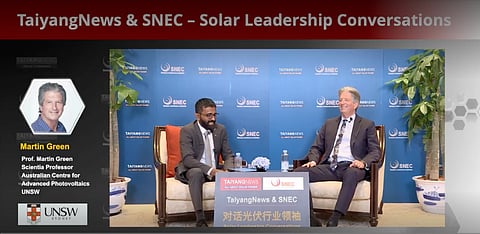

Renowned as the 'Father' of Modern Photovoltaics and Scientia Professor of the Australian Centre for Advanced Photovoltaics at the University of New South Wales (UNSW) in Australia, Professor Martin Green sat down for an exclusive interview with TaiyangNews' Head of Technology Shravan Chunduri as part of TaiyangNews & SNEC Solar Leadership Conversations during the SNEC Conference & Exhibition 2023 in Shanghai.
Invented back in 1983, PERC was initially thought to be not a commercial bet, but the industry has made it a sophisticated technology whose mass production module efficiency today exceeds 21.7%.
While his team was able to achieve 23% efficiency in 1986 for shingled modules using cells developed for solar car racing, Green sees it difficult for commercial PERC module efficiency to go beyond 22% without some major change in current times.
As gigantic TOPCon capacity expansions are announced globally, Green recalled PERC taking over from back surface field (BSF) technology in 2016, and by 2018 it completely dominated the industry. He believes it could be the same pattern for TOPCon, however there are other technologies that are fast catching up particularly with interdigitated back contact (IBC) cells and module announcements.
"To me, it suggests we could see transition to IBC technology occurring more quickly than people think," stated Green. "If the industry transitions more quickly to an all rear contact cells, of which there is a little bit of evidence for a trend to occur, you could see heterojunction (HJT) getting well ahead of TOPCon in performance."
Green said, "A lot of people think TOPCon is a new technology, but we made the 1st TOPCon cell in 1981 before we even thought of PERC."
Even as the industry is able to respond to increasing volume of production by cutting down on the use of silver quite effectively by going multi-busbar (MBB), Green is optimistic of some alternate silver technologies coming into commercialization.
He did point out that while the use of silver per cell is coming down as it is, the volume of solar cells being produced is increasing too. Demand from the solar industry may push up silver prices in the future, according to Green, which may force in the industry to switch to alternative metallization materials.
"The difficulty with TOPCon as I see it is probably the boron diffusion required on the top surface at the moment that's the performance limiting feature of the design," according to Green. Another challenge for TOPCon will be other technologies surpassing it.
As for HJT even though it is a niche market as of now, Green thinks if it can get rid of silver and replace it with copper or other metallization, its market prospects can improve. Throw in all back contact configuration, it will have additional advantages.
He also opined that perovskite-silicon tandem technology still needs time to become a commercially viable solution. Real challenge lies in independent field testing of these modules. According to Green, it will be challenging to commercialize perovskite-silicon tandem cell technology by 2030.
The complete interview with Professor Martin Green can be viewed on TaiyangNews' YouTube channel.
.png?w=50&fm=png)